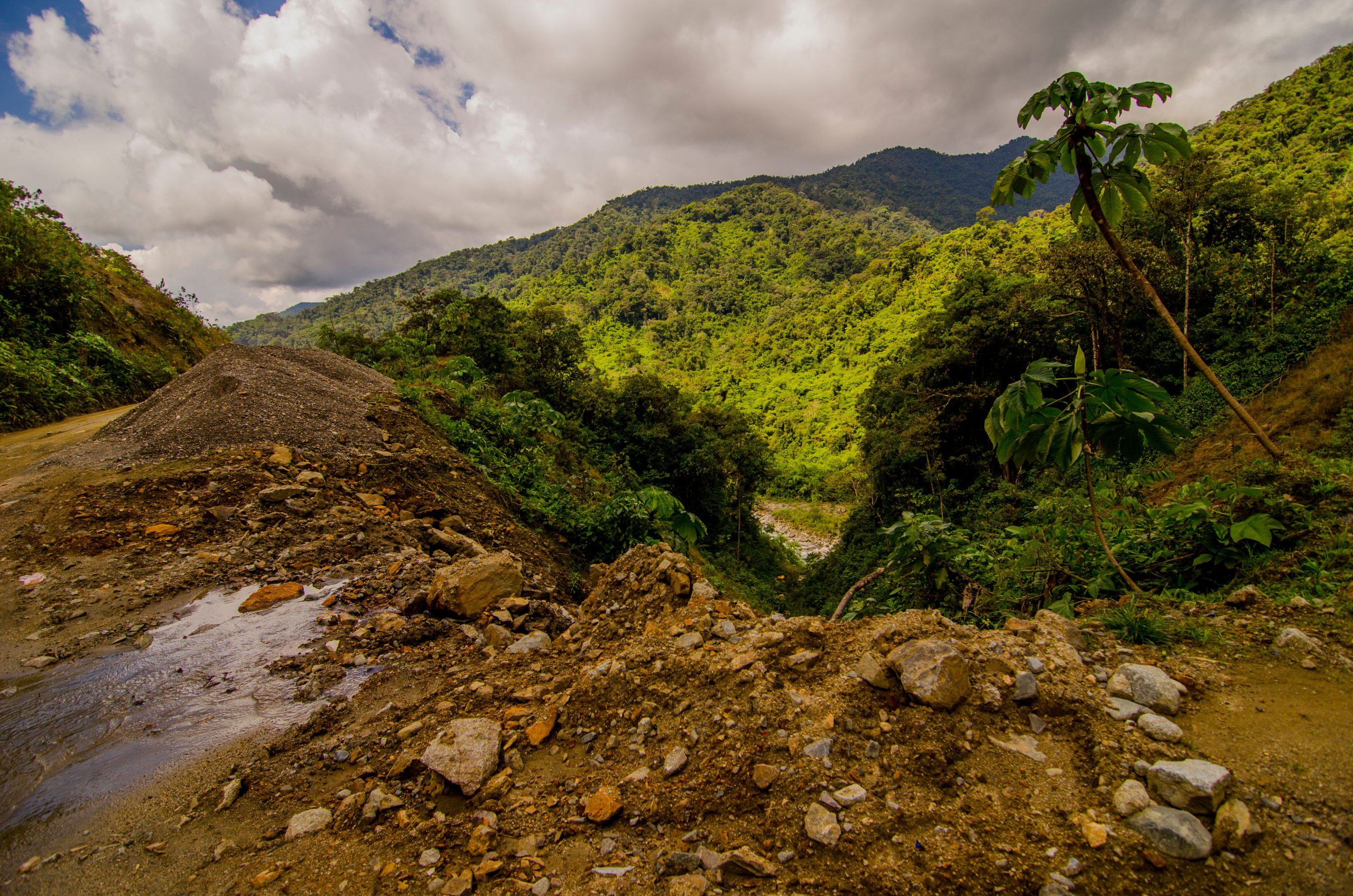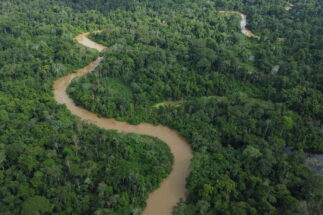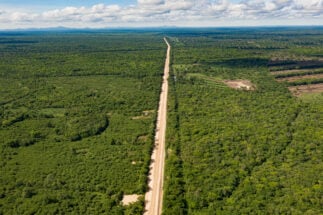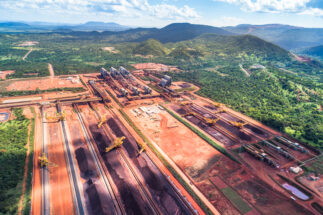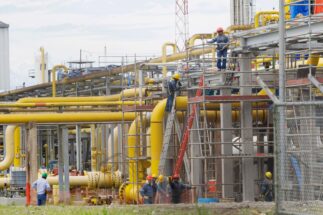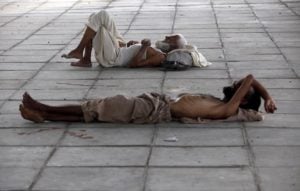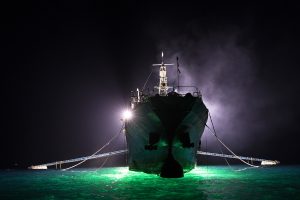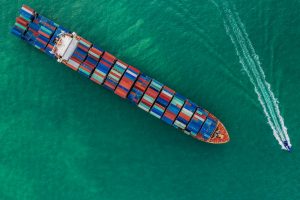The jungle of the Alto Madre de Dios river, in southeastern Peru is not only one of the most biodiverse areas in the world, but also home to several indigenous groups in voluntary isolation or first contact. According to figures provided by the country’s Ministry of Culture, between 2011 and 2015, there were more than 150 encounters with or sightings of these populations – practically one every 10 days – including the Mashco Piro people, one of the few remaining groups in voluntary isolation in the Amazon.
It is also here in these unique forests that the construction of the Cusco–Madre de Dios Road Corridor is set to be carried out – one of the most important road projects in the Peruvian Ministry of Transport and Communications’ (MTC) current portfolio, but one that has put environmentalists and indigenous leaders on alert.
The Cusco–Madre de Dios Road Corridor
This new 270 km route aims to improve connections between the Peruvian regions of Cusco and Madre de Dios, incorporating and upgrading three existing roads as part of a US$59 million investment
The Cusco–Madre de Dios corridor is part of the Proregión programme launched in 2017 by the Ministry of Economy and Finance, which aims to improve the country’s connectivity by improving regional-level roads. Funding is being issued by the transport ministry via a government scheme for ‘decentralising’ infrastructure, with additional initial financing coming from the Inter-American Development Bank (IDB) and the Development Bank of Latin America (CAF). The two banks have together loaned more than US$340 million to be invested in over 4,200 kilometres of roads in Peru.
The tender to build the road was won in January 2020 by the CCECC Peru Consortium, consisting of the Peru branch of the China Civil Engineering Construction Corporation – which holds a 90% stake – and Road Solutions, a Peruvian company with the remaining 10% share. This contracting has, however, been somewhat controversial, with the former being investigated as part of an alleged “criminal network”, from which Chinese construction companies allegedly won million-dollar tenders with the MTC in exchange for bribes – claims that the company has rejected.
While these scandals swirl at the higher levels, on the ground, apprehension around the new corridor is growing. It is by no means the first controversial road built through sensitive areas of Peru, with the flagship Southern Interoceanic Highway that runs through the Madre de Dios region a notable example. But such previous experiences are stoking concerns that this latest project may alter landscapes and communities, threaten indigenous territories and even fuel illicit activity – issues that some observers feel have been inadequately addressed by authorities, as doubts hang over the project’s social and environmental impact assessments.
Communities vulnerable
What will become the Cusco–Madre de Dios corridor is currently little more than a few dirt roads, which seem to melt to slush with the rains. The aim is to incorporate the routes of three current roads – the CU-112, CU-113 and MD-103 – paving over 270 kilometres in order to improve transit and links between the two regions of Cusco and Madre de Dios. The total investment for the work amounts to 220 million Peruvian sol (about US$59 million), spread over six years.
Of the 270 km length, 189 km cross the buffer zones of the Manu National Park and the Amarakaeri Communal Reserve. Both are protected areas, though various investigations and Peruvian state institutions have confirmed the presence of drug trafficking, clandestine airstrips and illegal coca leaf plantations in their buffer zones. The district of Kosñipata in Cusco, a coca leaf hotspot, is one of the points through which the road crosses. However, these details are not included in the project’s environmental assessment, nor do they appear in any related planning documents.
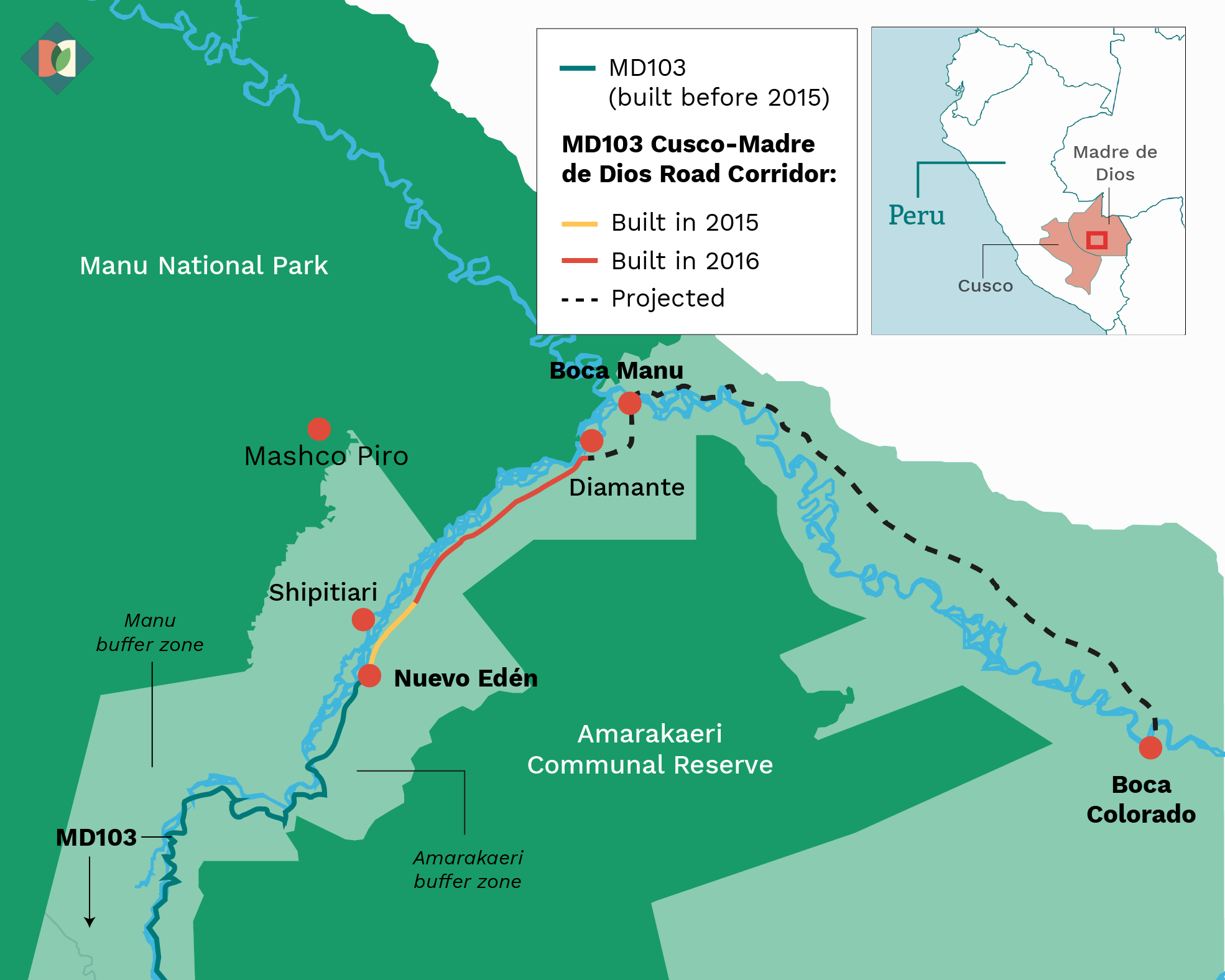
“Peru is one of the few countries with populations in voluntary isolation or first contact. If, as a state, you need to improve the living conditions of its citizens, you need to identify some mechanism for the protection of peoples in isolation, not just consider environmental standards,” said Baldovino.
Luis Felipe Torres, an anthropologist and researcher on voluntarily isolated peoples, pointed out that this corridor is being integrated with a road between Cusco and Madre de Dios that for years had undergone unofficial extensions, including towards an indigenous community in the village of Diamante. Within this area, there are two “control and vigilance posts” belonging to the Ministry of Culture, where protection agents of the Yine and Matsigenka peoples, as well as the Native Federation of the Madre de Dios River (FENEMAD) work. Meanwhile, within the Madre de Dios Territorial Reserve to the north of Diamante, there are a total of three checkpoints dedicated to the protection of Mashco Piro people.
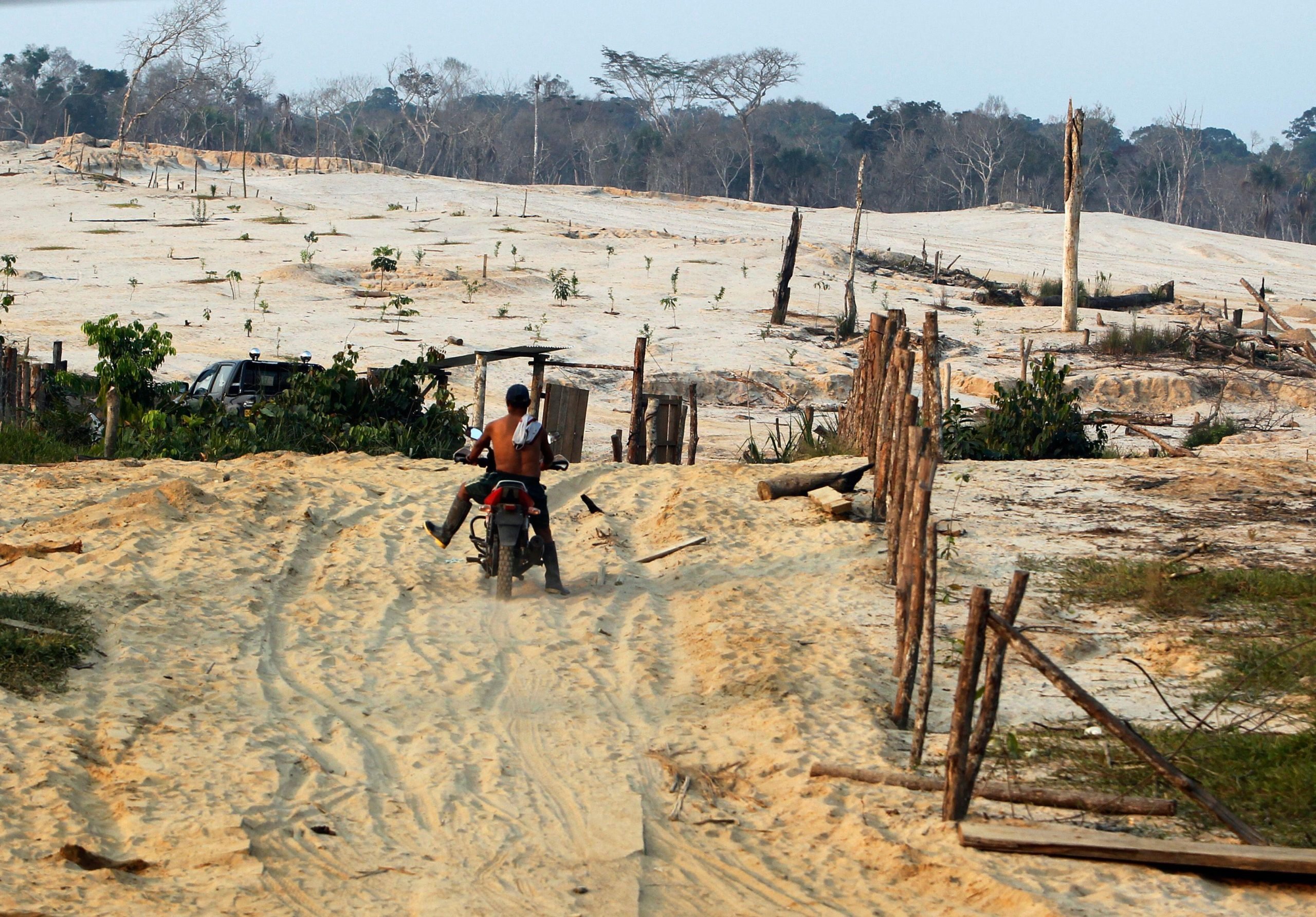
Protection, however, is an increasing uphill battle, as the building and planning of roads continues. “The state establishes special policies in favour of peoples in voluntary isolation and first contact, which are based on protecting a territory so that these populations can live autonomously. However, this road complicates the territorial protection of the park,” Torres said. “We already had this experience with the Interoceanic Highway, which increased deforestation and settlement exponentially.”
Diálogo Chino asked the Ministry of Culture about the impacts that the Cusco–Madre de Dios corridor could have on isolated indigenous peoples, but their written response made no direct comment on the project.
Authorities put environment second
Julio Cusurichi, president of FENEMAD, which represents 39 communities in Cusco and Madre de Dios, explains that they have repeatedly warned of the threat of a road crossing the aforementioned protection zones. Their fear goes beyond mass migration and the exacerbation of illicit economies, but also includes the vulnerability of peoples in voluntary isolation.
“The regional government of Madre de Dios built a road years ago without any study of the infrastructure. It is a road that was made without consideration of legal security for the territories of the communities,” explained Cusurichi, in reference to the initiative of the former regional government of Madre de Dios in 2015, which saw a road built between the villages of Nuevo Eden and Boca Colorado.
A technical opinion on the improvement of the Cusco–Madre de Dios road corridor issued by SERNANP, the national service for natural protected areas, was “favourable” to the work proceeding. John Flores, head of the Manu National Park, said that this assessment focused exclusively on the direct impacts of the road on the two natural protected areas – Manu itself, and the Amarakaeri Communal Reserve – rather than their associated buffer zones. According to Flores, it was not up to SERNANP to comment on the impact on buffer zones because this is the responsibility of the National Forestry and Wildlife Service (SERFOR).
We can influence almost nothing, while the authorities put environmental issues and protected areas in second place
However, when reminded of experiences relating to the Southern Interoceanic Highway – built through the nearby Tambopata National Reserve’s buffer zone, and which generated an increase in illegal mining that constantly threatens the reserve – Flores accepted that any road construction or improvement comes with potentially negative impacts.
“There are issues where we can influence almost nothing. Especially when there is strong social pressure. That should take precedence over the authorities – and I am referring to the Ministry of Transport and Communications, the local and regional government, who are the ones who put pressure for this to be developed,” Flores said. “Sometimes they put environmental issues and protected areas in second place.”
Diálogo Chino requested an interview with a representative of SERFOR about the impacts of the project. The response was that they already provided a technical assessment at the request of the General Directorate of Environmental Affairs of the MTC, and cannot give further details on the impacts of the project. Despite several requests for comment, the MTC did not respond to queries.
Flawed impact assessments
The project for the improvement and conservation of the Cusco–Madre de Dios Road Corridor required an environmental impact statement (DIA), rather than a detailed impact assessment (EIA-d) – the latter being the most rigorous environmental management instrument in Peru, and which any large-scale project must submit to the state to mitigate possible negative impacts on the environment and communities.
Unlike the EIA-d, the DIA applies to projects that are considered to have minor negative environmental impacts. This practice is established in the National System of Environmental Impact Assessment (SEIA) law of 2001. The DIA is granted based on anticipated impacts within a number of established categories, and is usually likely to be approved by the environment ministry. The controversy here is that the law does not consider paving a road to have serious consequences, although the evidence would show otherwise.
Ciro Salazar, a specialist in governance and environmental management for the NGO Derecho, Ambiente y Recursos Naturales (DAR), said the DIA is an environmental instrument that conditions a priori the idea that projects will not have negative impacts, despite the reality often being very different. He adds that this also influences the criteria used to choose the areas of direct influence of projects, as well as the real evaluation of impacts.
“This is related to a flaw in the public investment system. When the viability or construction of projects is declared, this is done with poor quality information, not only in socio-environmental terms, but also in economic and technical aspects,” Salazar told Diálogo Chino.

The specialist said that after evaluating a profiling study for the project, its DIA, a complementary environmental and social analysis, and an environmental and social management plan proposed by the Inter-American Development Bank (IDB), he surmised that information on certain realities surrounding the project – such as the presence of illegal activities, deforested areas and the presence of indigenous peoples in isolation, including the Mashco Piro – were not included in social and environmental assessments, meaning that there were no safeguards established to minimise the risks.
Salazar told Diálogo Chino: “From these documents, the full range of indirect impacts such as deforestation, change of land use and uncontrolled migration are unknown, despite the fact that you have the experience of the Southern Interoceanic Highway, which is an international case study. There is no mention of this in the study that evaluates the viability of this project, even though it crosses coca-growing areas.”
The specialist clarified that he does not question the need for improving connectivity, because there is an economic dynamic to consider in these localities. But he asserted that preventive measures should be taken in view of the high risks involved.
The pre-investment study of the project to which Salazar referred, published by the MTC, details some possible environmental and social impacts that could occur during the execution of the project. It refers to the possible alteration of air quality due to dust and gases, the generation of noise, as well as the alteration of soil and water quality. In addition, it warns about the impact on vegetation cover, and on the population, but not about illegal activities such as coca leaf cultivation, deforestation or the impact on peoples in voluntary isolation.
As work gets underway with these concerns around incomplete assessments and lacking information, what will happen in the coming months remains uncertain.
